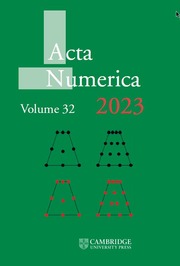Crossref Citations
This article has been cited by the following publications. This list is generated based on data provided by
Crossref.
Iserles, Arieh
and
Webb, Marcus
2021.
From Operator Theory to Orthogonal Polynomials, Combinatorics, and Number Theory.
Vol. 285,
Issue. ,
p.
239.
Carlström, Stefanos
Bertolino, Mattias
Dahlström, Jan Marcus
and
Patchkovskii, Serguei
2022.
General time-dependent configuration-interaction singles. II. Atomic case.
Physical Review A,
Vol. 106,
Issue. 4,
Goloskokov, Dmitriy P
and
Matrosov, Alexander V
2022.
Bending of clamped orthotropic thin plates: polynomial solution.
Mathematics and Mechanics of Solids,
Vol. 27,
Issue. 11,
p.
2498.
Dong, Xinyang
Gull, Emanuel
and
Strand, Hugo U. R.
2022.
Excitations and spectra from equilibrium real-time Green's functions.
Physical Review B,
Vol. 106,
Issue. 12,
Gutleb, Timon
Carrillo, José
and
Olver, Sheehan
2022.
Computing equilibrium measures with power law kernels.
Mathematics of Computation,
Vol. 91,
Issue. 337,
p.
2247.
Klippenstein, Brock
and
Slevinsky, Richard Mikaël
2022.
Fast associated classical orthogonal polynomial transforms.
Journal of Computational and Applied Mathematics,
Vol. 403,
Issue. ,
p.
113831.
Trefethen, Lloyd N.
2022.
Exactness of Quadrature Formulas.
SIAM Review,
Vol. 64,
Issue. 1,
p.
132.
Bilman, Deniz
Nabelek, Patrik
and
Trogdon, Thomas
2023.
Computation of large-genus solutions of the Korteweg–de Vries equation.
Physica D: Nonlinear Phenomena,
Vol. 449,
Issue. ,
p.
133715.
Gutleb, Timon S.
Carrillo, José A.
and
Olver, Sheehan
2023.
Computation of Power Law Equilibrium Measures on Balls of Arbitrary Dimension.
Constructive Approximation,
Vol. 58,
Issue. 1,
p.
75.
Pu, Tianyi
and
Fasondini, Marco
2023.
The numerical solution of fractional integral equations via orthogonal polynomials in fractional powers.
Advances in Computational Mathematics,
Vol. 49,
Issue. 1,
Liu, Zexin
and
Narayan, Akil
2023.
A Stieltjes Algorithm for Generating Multivariate Orthogonal Polynomials.
SIAM Journal on Scientific Computing,
Vol. 45,
Issue. 3,
p.
A1125.
Fasondini, Marco
Olver, Sheehan
and
Xu, Yuan
2023.
Orthogonal polynomials on a class of planar algebraic curves.
Studies in Applied Mathematics,
Vol. 151,
Issue. 1,
p.
369.
Van Buggenhout, Niel
2023.
On generating Sobolev orthogonal polynomials.
Numerische Mathematik,
Vol. 155,
Issue. 3-4,
p.
415.
Gutleb, Timon S.
and
Carrillo, José A.
2023.
A static memory sparse spectral method for time-fractional PDEs.
Journal of Computational Physics,
Vol. 494,
Issue. ,
p.
112522.
Iserles, Arieh
and
Webb, Marcus
2023.
Sobolev‐orthogonal systems with tridiagonal skew‐Hermitian differentiation matrices.
Studies in Applied Mathematics,
Vol. 150,
Issue. 2,
p.
420.
Strössner, Christoph
and
Kressner, Daniel
2023.
Fast global spectral methods for three-dimensional partial differential equations.
IMA Journal of Numerical Analysis,
Vol. 43,
Issue. 3,
p.
1519.
Ellison, Abram C.
and
Julien, Keith
2023.
Gyroscopic polynomials.
Journal of Computational Physics,
Vol. 489,
Issue. ,
p.
112268.
Mortensen, Mikael
2024.
A Faster Multipole Legendre–Chebyshev Transform.
SIAM Journal on Scientific Computing,
Vol. 46,
Issue. 6,
p.
A3803.
Xu, Yuan
2024.
Orthogonal polynomials on domains of revolution.
Studies in Applied Mathematics,
Vol. 153,
Issue. 2,
Proulx, Ronald J.
and
Ross, Isaac M.
2024.
Implementations of the Universal Birkhoff Theory for Fast Trajectory Optimization.
Journal of Guidance, Control, and Dynamics,
Vol. 47,
Issue. 12,
p.
2482.

